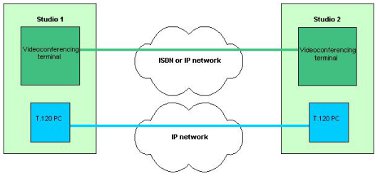Out-of-band data sharing
Videoconferencing applications are real-time applications that generate large amounts of data which need to be transported across networks very quickly to be of use. Even slight delays in the transmission of data can result in impairments to picture or audio quality. For these reasons it makes sense to give the audio and video a clear path, without the extra data traffic of the T.120 session. The out-of-band method relies on a completely separate call being made for the data sharing element of a conference.
Where the call is an Internet call (IP/H.323) the transmitted information is competing with all of the other services that are running on the networks that it traverses between the source and destination of the call. All web surfers have experienced the apparently unpredictable ebbs and flows of data transfer over the Internet: web pages can be fast one day and slow the next according to who else is using the net, and what they are doing. In fact these ebbs and flows take place over seconds and fractions of seconds too. These changes cause variations in the speed and regularity of the arrival of data at its destination, which can in turn affect the quality of the play-out of audio and video.
Data sharing is not quite so time-sensitive. A delay of half a second on the update of a presentation can in most situations be tolerated without affecting the quality of the interaction. For this reason it makes sense to extract the data sharing information from the video and audio, so that it is not competing with them for precious network resources, so a separate call is made for the data sharing element of the conference.
Figure 2. Out-of-band data sharing
The desktop PC that is attached to a Local Area Network (that is in turn able to access the Internet) has become so ubiquitous that it provides the simplest and most cost-effective solution to setting up a separate, parallel call over the Internet for the data sharing session. This data-only Internet call can complement an audio/video conference irrespective of whether the conference is using the Internet or ISDN as its network connection. The out-of-band method also results in a better quality of image than any of the in-band methods as there is no conversion of format, interleaving or contention for finite resources.
Janet Videoconferencing does not currently support the use of in-band data sharing. This policy has been built on experience of the use of both the in-band and out-of-band methods. In-band data sharing compromises the amount of video and audio data that can be passed between the end systems involved in a conference. Out-of-band data sharing keeps the video and audio exchanged between systems completely separated from any data sharing information that they exchange. Keeping these separated and distinct allows network engineers to treat them differently: for example by prioritising the real-time services (audio and video) over the data sharing.
The out-of-band method as described here gives a level of flexibility, interactivity and quality that is often not possible using in-band methods. This method helps to avoid potential problems caused by incompatibilities between end systems or their software. It also allows JANET network engineers to apply appropriate support within the network to optimise the quality of each conference. The next section examines in some detail Microsoft Netmeeting, the software which is currently in general use to facilitate out-of-band data sharing.






